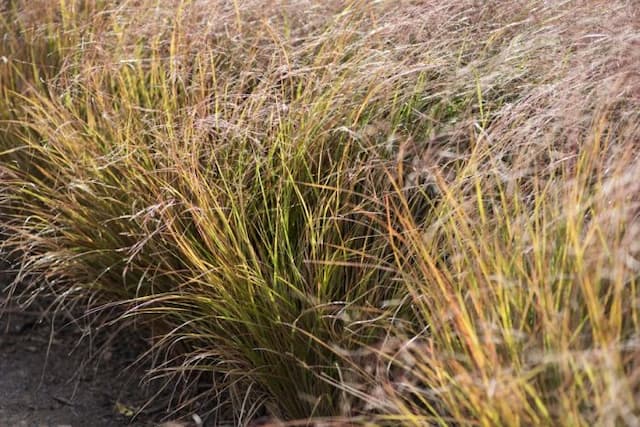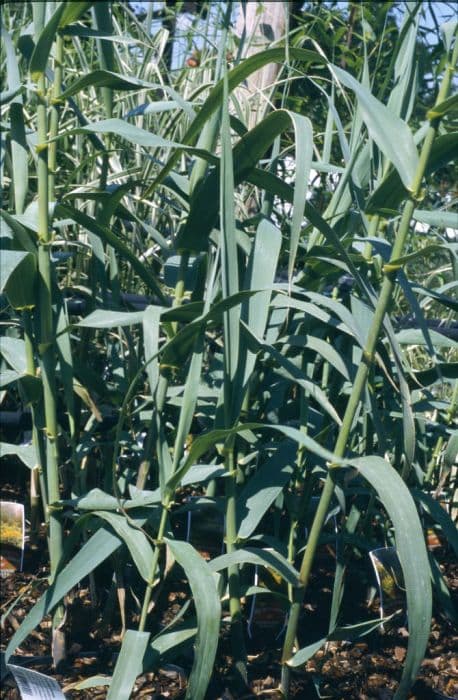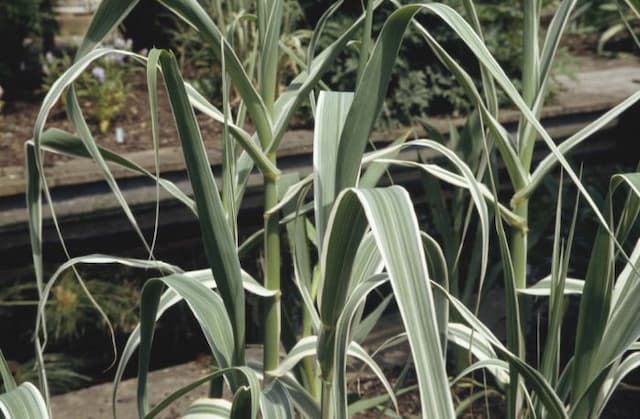Variegated Dwarf Bamboo Pleioblastus chino f. aureostriatus (v)

ABOUT
The plant, commonly known as Dwarf Whitestripe bamboo, is a small, ornamental grass notable for its striking appearance. It has narrow leaves that exhibit a variegated pattern, with cream or yellow stripes contrasting against a green background. This striping gives the leaves a fresh and vibrant look, particularly when they rustle in the breeze. The canes of the Dwarf Whitestripe bamboo, which support the leaves, are typically green and may sometimes show a hint of the variegation found in the leaves. The growth habit of this plant is compact and tidy, often forming a dense clump that can be used as a feature in garden designs. The overall impression of Dwarf Whitestripe bamboo is of a bright and elegant grass that brings lightness and an exotic touch to the spaces where it is planted.
About this plant
 Names
NamesSynonyms
Variegated Dwarf Fernleaf Bamboo, Golden Variegated Bamboo
Common names
Arundinaria chino f. aureostriata, Pleioblastus chino var. viridistriatus, Pleioblastus viridistriatus.
 Toxicity
ToxicityTo humans
Pleioblastus chino f. aureostriatus, commonly known as Variegated Dwarf Bamboo, is not known to be toxic to humans. However, it's always advisable to avoid ingesting plants that are not specifically meant for consumption as they can sometimes cause irritation or an allergic reaction.
To pets
Variegated Dwarf Bamboo is not known to be toxic to pets. However, it is always best to prevent pets from chewing on plants as a general precaution. Some pets may have a sensitivity or allergic reaction to plants that are not known to be poisonous.
 Characteristics
CharacteristicsLife cycle
Perennials
Foliage type
Evergreen
Color of leaves
Variegated
Height
4 feet [1.2 meters]
Spread
3 feet [0.9 meters]
Plant type
Shrub
Hardiness zones
6
Native area
Asia
Benefits
 General Benefits
General Benefits- Ornamental Appeal: Adds visual interest to gardens with its variegated foliage that displays green leaves with yellow stripes.
- Low Maintenance: Requires minimal care once established, making it an easy choice for gardeners of all levels.
- Fast Growth: Grows quickly, providing swift coverage for desired areas or creating living barriers in a short time.
- Soil Erosion Control: Its root system helps stabilize the soil, preventing erosion in sloped gardens and landscaped areas.
- Privacy Screen: Can be used as a dense hedge or screen, offering privacy for yards and outdoor living spaces.
- Wildlife Habitat: Provides shelter and potential nesting sites for birds and small wildlife within a garden ecosystem.
- Versatility: Adapts to a variety of garden designs, from traditional to contemporary, due to its unique aesthetic.
 Medical Properties
Medical PropertiesThis plant is not used for medical purposes.
 Air-purifying Qualities
Air-purifying QualitiesThis plant is not specifically known for air purifying qualities.
 Other Uses
Other Uses- Craft material: The canes of Pleioblastus chino, also known as Dwarf Fernleaf Bamboo, can be used for crafting various items such as flutes, small furniture pieces, and ornamental objects.
- Erosion control: Due to its dense and fast-growing root system, Dwarf Fernleaf Bamboo can be planted on slopes or areas prone to soil erosion to help stabilize the ground.
- Sound barrier: When planted densely, this bamboo can act as an effective sound barrier, reducing noise pollution from roads or neighboring properties.
- Privacy screen: The compact and bushy growth habit of Dwarf Fernleaf Bamboo makes it ideal for creating private garden spaces or shielding unsightly views.
- Livestock feed: In some cultures, the leaves and shoots of Dwarf Fernleaf Bamboo may be used as supplemental fodder for livestock like goats or cattle.
- Windbreaks: The strong and flexible nature of this bamboo variety makes it suitable for planting as windbreaks around agricultural fields.
- Edging: The distinctive variegated leaves can be used to create visually appealing garden borders or pathways.
- Culinary usage: While not common, the young shoots of Pleioblastus chino might be edible when properly prepared and cooked, similar to some other bamboo species.
- Fishing poles: The strong, flexible canes are suitable for making simple, traditional fishing rods.
- Artistic inspiration: The unique appearance of the variegated leaves may serve as inspiration for artists and photographers.
Interesting Facts
 Feng Shui
Feng ShuiVariegated Dwarf Bamboo is not used in Feng Shui practice.
 Zodiac Sign Compitability
Zodiac Sign CompitabilityVariegated Dwarf Bamboo is not used in astrology practice.
 Plant Symbolism
Plant Symbolism- Resilience: As a bamboo variety, the Pleioblastus chino f. aureostriatus, commonly known as Variegated Dwarf Bamboo, represents resilience due to its ability to bend in strong winds without breaking.
- Flexibility: The flexible nature of the bamboo culms symbolizes adaptability and openness to change.
- Growth and Vitality: Bamboo is a rapidly growing plant, which often symbolizes swift growth, vitality, and physical and spiritual nourishment.
- Good Fortune: In many Eastern cultures, bamboo is considered a bringer of good fortune and is often associated with prosperity and success.
- Longevity: The long life span of bamboo makes it a symbol of longevity and immortality.
 Water
WaterThe Dwarf Fernleaf Bamboo should be watered generously to ensure the soil stays moist but not waterlogged. Typically, watering once a week with about 1 to 1.5 gallons of water during the growing season is sufficient, but this can vary depending on climate and weather conditions. In hotter, drier periods, it may require more frequent watering. During winter, reduce watering to about once every two weeks or when the soil appears dry. Always check the top inch of soil for dryness before watering.
 Light
LightDwarf Fernleaf Bamboo thrives in partial shade to full sun. The best spot for this plant is one where it can enjoy morning sunlight and afternoon shade, to protect it from the intense heat of the day. It can tolerate full sun, but the leaves may suffer from scorch in extremely hot climates without some respite from the afternoon sun.
 Temperature
TemperatureThe Dwarf Fernleaf Bamboo prefers moderate to warm temperatures, thriving between 50°F and 80°F. It can tolerate temperatures as low as 20°F without significant damage and as high as 95°F, as long as it has adequate water. The ideal temperature range for this plant is when it's not exposed to prolonged frost or extreme heat.
 Pruning
PruningPruning the Dwarf Fernleaf Bamboo is important to maintain its shape and encourage new growth. Trim back the plant in late winter or early spring before new shoots emerge to remove any dead or damaged canes and control its spread. Pruning can be done annually, and it's the best time to thin out the clump to rejuvenate older plants.
 Cleaning
CleaningAs needed
 Soil
SoilVariegated Dwarf Bamboo prefers a well-draining soil mix that can retain moisture without becoming waterlogged. Aim for an equal mix of soil, compost, and perlite or sand. The soil pH should be slightly acidic to neutral, around 5.5 to 7.
 Repotting
RepottingVariegated Dwarf Bamboo should be repotted every two to three years to refresh the soil and accommodate the growth of the bamboo's root system. Spring is the optimal time to repot this plant.
 Humidity & Misting
Humidity & MistingVariegated Dwarf Bamboo thrives in moderate to high humidity levels. It is best to maintain humidity around 40-60% for optimal growth and health. Avoid placing the plant in very dry environments.
 Suitable locations
Suitable locationsIndoor
Provide bright, indirect light and maintain moderate humidity.
Outdoor
Plant in partial shade, protect from harsh sun and winds.
Hardiness zone
6-9 USDA
 Life cycle
Life cyclePleioblastus chino f. aureostriatus, commonly known as Dwarf Whitestripe Bamboo, begins its life cycle when the seeds germinate in favorable conditions, usually moist soil with ample shade. The seedlings quickly establish a root system and sprout their first shoots. As the plant matures, it develops a network of rhizomes, which are underground stems that allow for vegetative reproduction and the spread of the plant. The bamboo then enters a phase of rapid vertical growth, producing characteristic culms, or stems, with alternating leaves showcasing yellow stripes on green. Over time, these culms can reach their maximum height of about 3 to 4 feet, with the plant spreading outwards to form dense clumps. Finally, this perennial may flower, but flowering is rare and can lead to the decline or death of the specific bamboo after seed production.
 Propogation
PropogationPropogation time
Spring-Early Summer
The Pleioblastus chino f. aureostriatus, commonly known as variegated dwarf bamboo, is most commonly propagated through division. This method involves physically separating the bamboo's clumps into smaller sections, each with at least one growing culm or shoot and accompanying root mass. The best time to carry out division is in the late winter to early spring, just before the growing season begins, which allows the divisions to establish themselves during the upcoming growth period. To divide, you dig around the clump you intend to separate, ensuring you have a substantial amount of roots attached to each section. After the division, replant each section at the same depth it was growing at previously, and water it thoroughly to help establish the plant in its new location.









